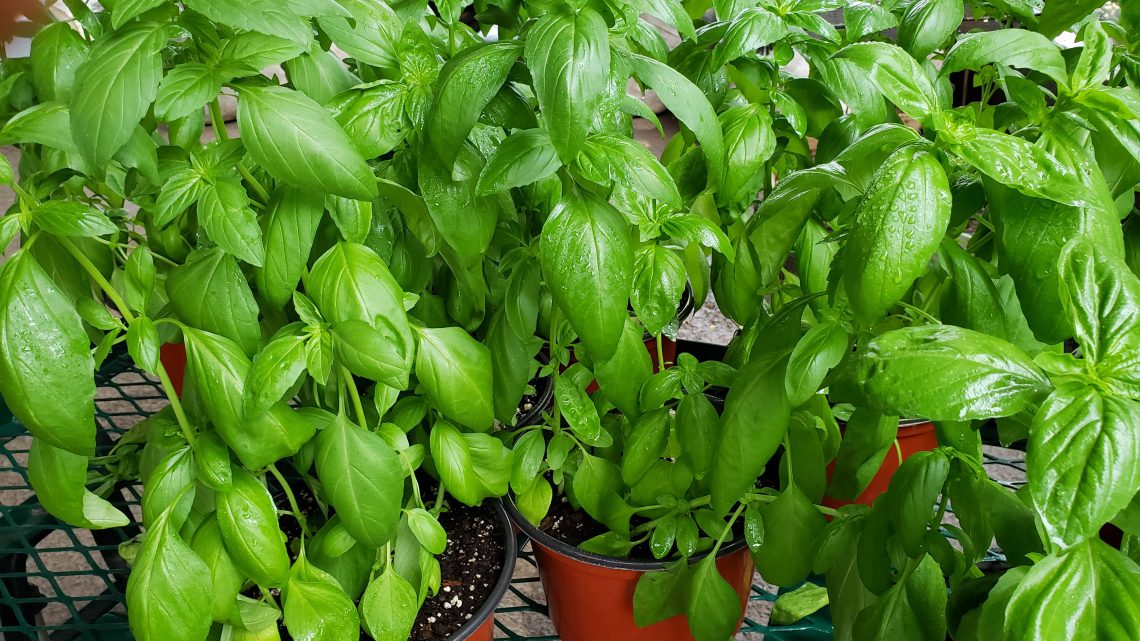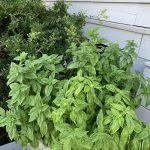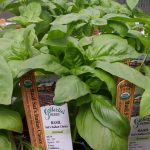My basil plants failed this year. I don’t know why.
Every year I have a pot on the front steps where I pick leaves to bring the flavor of summer to all manner of dishes. Snipping a few to cut into a chiffonade and scatter over vine ripe tomato slices is one of the best uses. In addition to snipping here and there, I hope to get one big cut mid-season with enough to make a batch of pesto sauce.
It won’t happen this year. The leaves curled in on themselves wrinkling unpleasantly. Brown spots grew to engulf entire leaves. The stems yellowed. It was an unexpected failure after years of success. Gardening is not for the faint of heart.
A few feet away pots of herbs — sage, thyme, parsley, tarragon, and rosemary — are thriving. The problem is just with the basil.
I’m really going to miss the fresh made pesto. Home-made seems to taste better, especially when the raw material is harvested from my front steps. It’s farm to table writ small.
My friend David sent me a picture of a planter packed with healthy basil grown by his wife Joan on the coast of South Carolina. It seems pretty hot for basil that far south, but their pot was lush and green. He told me they got a nice batch of pesto out of it.
I usually use a traditional recipe that calls for two cups of packed basil leaves, pine nuts, garlic, olive oil, and a handful of freshly grated Parmesan cheese all whirled up in a food processor. Once the leaf-washing chore is done, it’s astonishingly easy. The resulting pesto is bright green and thick, almost a paste, but packed with flavor. It can easily be thinned out with more oil when needed.
With a jar of pesto in the frig, it’s easy to whip up a summery pasta dinner (maybe some tortellini) sauced with pesto, or sauté some shrimp and finish them with a generous spoonful of pesto and a splash of cream. For a taste of summer, thin it out with fragrant olive oil and drizzle across sliced field-ripened tomatoes.
Mix a little pesto into mayonnaise (homemade if you’re really serious) for a fresh tasting dressing for cold pasta, seafood, or chicken salad. Use the same mayo mix on a BLT to take that summer classic to the next level. Pesto is good almost anywhere.
The pesto will darken on the top when exposed to air, losing its bright green color on just a thin layer. It doesn’t affect the flavor, just mix it in. A little olive oil can be floated on the pesto to seal it from the air. You’re probably going to stir in more oil anyway.
Pesto originally comes from Liguria, the stretch of Mediterranean coast known as the Italian Riviera surrounding Genoa. It seems to me that it hit American cooking consciousness around the same time as sun-dried tomatoes. While the tomatoes have been relegated to the back of the shelf, pesto has stayed with us and developed many variations.
The original recipe calls for pine nuts which are actually seeds and not classified as tree nuts. (None-the-less, there may be allergy issues for some people.) Pine nuts are expensive, but other nuts can be used instead. Ina Garten suggests walnuts and pine nuts fifty-fifty. Walnuts, almonds, or pecans are commonly substituted for pine nuts. Going even further afield, sunflower seeds, hazelnuts, or pistachios can be used. The nuts provide texture as much as flavor.
When David and Joan talked up their project, there were lots of variations among fellow pesto makers — walnuts and almonds were the favorite nut substitutions. Everyone seems to have a preference.
The summer-fresh flavor of the basil is the draw for me. But I have heard of pesto being made with other leafy herbs like parsley, cilantro, or spinach.
In the pre food processor era, pesto was made by hand with a mortar and pestle, ground to a paste with a good deal of effort. Purists will tell you the texture is more authentic, but I’m not doing all that work. Some say that finely chopped (but not puréed) is the way to go, particularly if the pesto is being used to dress pasta. That may be so, but the flavor is my thing, and the ease of the food processor is ideal for a lazy cook like me.
I won’t go without homemade pesto this year. The farmers markets are a great source for locally-grown fresh-picked basil. It’s not quite the same as the homegrown leaves on my front steps, but I don’t think I’ll be able to tell the difference.














No Comment